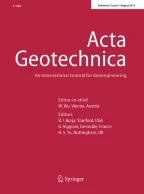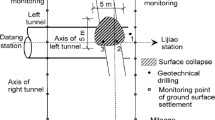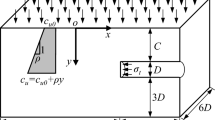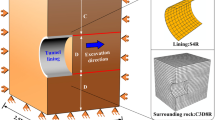Upper bound analysis of tunnel face stability in layered soils

The working face of tunnel constructions has to be kept stable during tunneling to prevent large soil deformations or fatal failure. In layered soils with lower cohesion, failures happen more often and more abrupt than in cohesive soils. Therefore, the maintenance of a proper support pressure at the tunnel working face is of high importance. In this paper, an upper bound analysis is introduced to investigate the minimum support pressure for the face stability in layered soils. A three-dimensional kinematically admissible mechanism for the upper bound analysis is improved to model potential failure within different soil layers. An analytical solution for the support pressure assessment is achieved. The influence of the crossing and cover soil on the face stability is analyzed, respectively. This solution provides an analytical estimation of the minimum support pressure for the face stability. It may be used as a reference for projects under similar conditions.
This is a preview of subscription content, log in via an institution to check access.
Access this article
Subscribe and save
Springer+ Basic
€32.70 /Month
- Get 10 units per month
- Download Article/Chapter or eBook
- 1 Unit = 1 Article or 1 Chapter
- Cancel anytime
Buy Now
Price includes VAT (France)
Instant access to the full article PDF.
Rent this article via DeepDyve
Similar content being viewed by others

Upper bound analysis for estimation of the influence of seepage on tunnel face stability in layered soils
Article 27 November 2016

Numerical analyses for three-dimensional face stability of circular tunnels in purely cohesive soils with linearly increasing strength
Article Open access 13 March 2024

A practical method for considering soil strain softening effect in the tunnel face stability analysis by numerical modeling
Article 29 October 2022
Explore related subjects
References
- Anagnostou G, Kovari K (1994) The face stability of slurry shield-driven tunnels. Tunn Undergr Space Technol 9(2):165–174 ArticleGoogle Scholar
- Anagnostou G, Kovari K (1996) Face stability conditions with earth pressure balanced shields. Tunn Undergr Space Technol 11(2):165–173 ArticleGoogle Scholar
- Broere W (1998) Face stability calculations for a slurry shield in heterogeneous soft soils. Tunnels and metropolises. Balkema, Rotterdam, pp 215–218 Google Scholar
- Broere W (2001) Tunnel face stability and new CPT applications. PhD thesis, Geotechnical Laboratory, Delft University of Technology
- Broere W, Van Tol AF (2000) Influence of infiltration and groundwater flow on tunnel face stability. In: Kusakabe O, Fujita K, Miyazaki Y (eds) Geotechnical aspects of underground construction in soft ground. Balkema, Rotterdam, pp 339–344 Google Scholar
- Chambon P, Corté JF (1994) Shallow tunnels in cohesionless soil: stability of tunnel face. J Geotech Eng 120(7):1148–1165 ArticleGoogle Scholar
- Davis EH, Gunn MJ, Mair RJ, Seneviratne HN (1980) The stability of shallow tunnels and underground openings in cohesive material. Geotechnique 30(4):397–416 ArticleGoogle Scholar
- Horn N (1961) Horizontaler Erddruck auf senkrechte Abschlussflächen von Tunnelröhren. In: Landeskonferenz der Ungarischen Tiefbauindustrie, pp 7–16 (in German)
- Jancsecz S, Steiner W (1994) Face support for a large mix-shield in heterogenous ground conditions. In: Tunneling’94. Institution of Mining and Metallurgy, London
- Janssen HA (1895) Versuche über Getreidedruck in Silozellen. Z Ver Dtsch Ing 35:1045–1049 (in German) Google Scholar
- Leca E, Dormieux L (1990) Upper and lower bound solutions for the face stability of shallow circular tunnels in frictional material. Geotechnique 40:581–606 ArticleGoogle Scholar
- Muelhaus HB (1985) Lower bound solutions for circular tunnels in two or three dimensions. Rock Mech Rock Eng 18(1):37–52 ArticleGoogle Scholar
- Powrie W (2002) Soil mechanics concept and application, 2nd edn. Taylor & Francis, New York Google Scholar
- Salencon J (1990) An introduction to the yield design theory and its application to soil mechanics. Eur J Mech A/Solids 9(5):477–500 MATHMathSciNetGoogle Scholar
Acknowledgments
The authors appreciate the constructive advices of Prof. Dr.-Ing. H. Balthaus to this paper. The research is supported by the Funding of the National Natural Science Foundation of China (Grant 51179168) and the Major Projects on Science and Technology of Development of Society of Zhejiang, China (Grant 2009C030081).
Author information
Authors and Affiliations
- Research Center of Coastal and Urban Geotechnical Engineering, Zhejiang University, 388 Yuhangtang Rd., Hangzhou, 310058, China Xiao-Wu Tang & Wei Liu
- Institut für Bauingenieurwesen, Technische Universität Berlin, Gustav-Meyer-Allee 25, 13355, Berlin, Germany Bettina Albers & Stavros Savidis
- Xiao-Wu Tang




